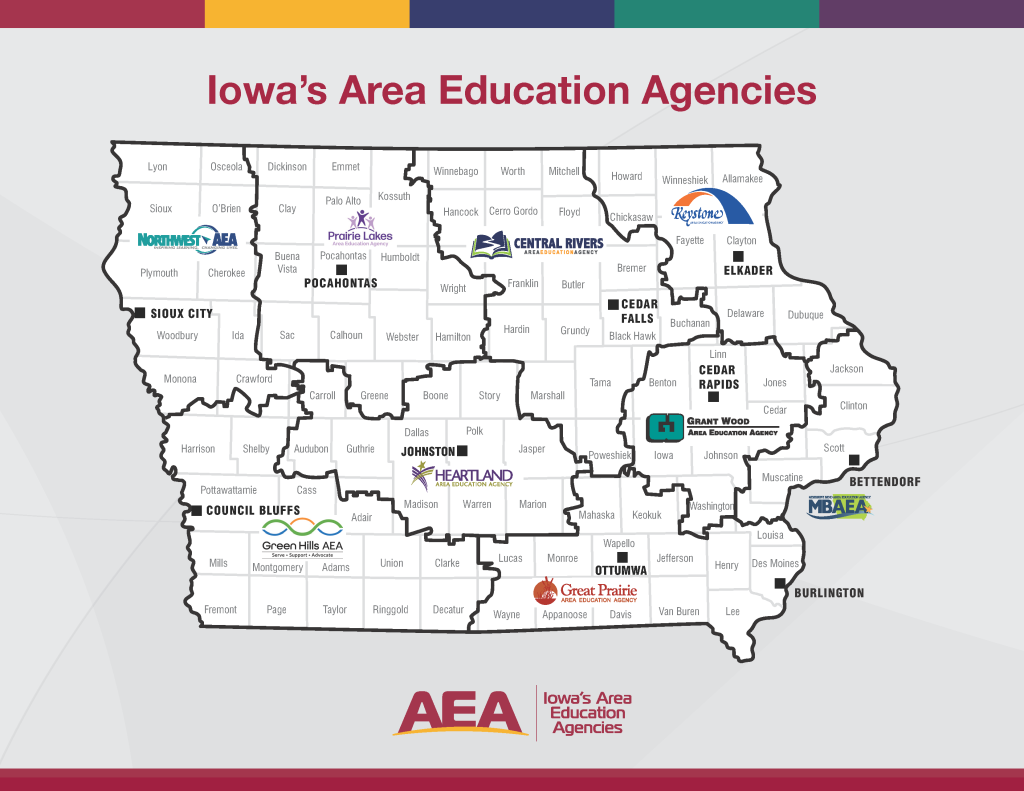Learn More About Iowa's Area Education Agencies

Iowa’s educational structure dates back to 1858, but the first regional services were not established until 1910 when Iowa school districts numbered over 5,000. In that year, county superintendents were appointed to oversee the schools in each county.
Over the years, the number of districts steadily declined. In 1957, the state legislature allowed counties to jointly employ one superintendent to handle the smaller number of districts. Then, in 1965, the legislature approved the merger of two or more counties into joint county school systems. But problems developed under this new arrangement. The availability of services varied greatly from one county or joint-county system to another.
The state legislature responded in 1974 by replacing county systems with 15 area education agencies to provide equity across the state. There are now nine AEAs due to voluntary mergers across the state. Since its inception, Iowa’s AEA system has been widely regarded as one of the finest systems of intermediate services in the country providing Special Education, Media, Curriculum, Instruction and Assessment, and Professional Learning support to children, families and educators since day one.
Standards for Service
Iowa's AEAs provides many programs and services for children, families, schools, and communities, all of which fall under nine state-required standards for service. All of Iowa’s AEAs adhere to these standards for service and are evaluated to ensure quality by the Iowa Department of Education on a regular cycle. Standards developed shall include, but are not limited to, the following:
School-Community Planning
Support for school-community planning, including a means of assessing needs, developing collaborative relationships among community agencies, establishing shared direction, and implementing program plans and reporting progress toward goals for all students, including students with disabilities.
Professional Development
Evidence-based professional development programs that respond to current needs
Curriculum, Instruction & Assessment
Support for curriculum development, instruction, and assessment services that address the areas of reading, language arts, math, and science, using research-based methodologies, for all students, including students with disabilities.
Special Education Support
Support for schools and school districts in providing special education services.
Diverse Learning Needs
Support for addressing the diverse learning needs of all children and youths, including children and youths who are eligible for special education through services that include direct services to students with disabilities.
Management
AEAs provide schools with management services if requested. These services may be provided on a “fee-for-service” basis and may be provided under cooperative agreements between AEAs.
Media Services
Support for instructional media services that supplement and support local district media centers and services.
School Technology
School technology services provide schools with technology planning, technical assistance and professional development. Services also support technologies to improve student achievement.
AEAs provide support necessary to implement effective instruction for all students, including students with disabilities, through school technology services.
District Library Support
Support for school district libraries in accordance with section 273.2, subsection 4.
Early Childhood Services
Iowa's AEAs provide support for early childhood service coordination for families and children, age birth through three years, to meet health, safety, and learning needs, including service coordination.
Submission of Required Reports
Timely submission of required reports and documents to the State Board of Education, the Department of Education, and the Division of Special Education of the Department of Education.
Analysis of Student Achievement Data
Iowa's AEAs support schools and school districts in analyzing student achievement data related to the learning environment, comparing data to the external knowledge base, and using that information to guide schools and school districts in setting goals and implementing actions to improve student learning for all students, including students with disabilities.
Educational Programs and Services
Support for students using educational programs and services in a manner that is consistent with the educational standards established pursuant to section 256.11.
Professional Development
Support for staff development and adult learners utilizing evidence-based professional development in a manner that meets the professional needs of staff and adult learners consistent with standards adopted by the State Board of Education.
Compliance with Federal and State Laws
Compliance with all relevant federal and state laws in the provision of services and supports to students with disabilities.
Privacy Policy
Iowa's AEAs do not share personal data (phone numbers) and consent with third parties/affiliates or partners.
